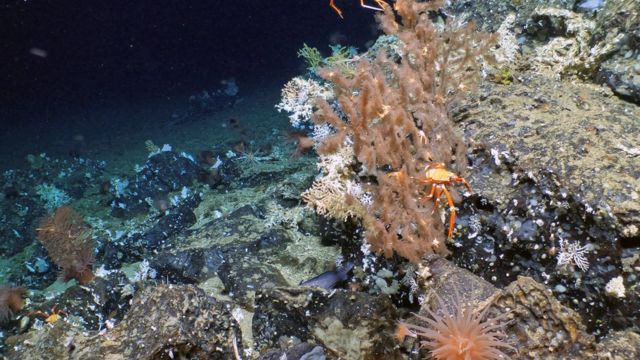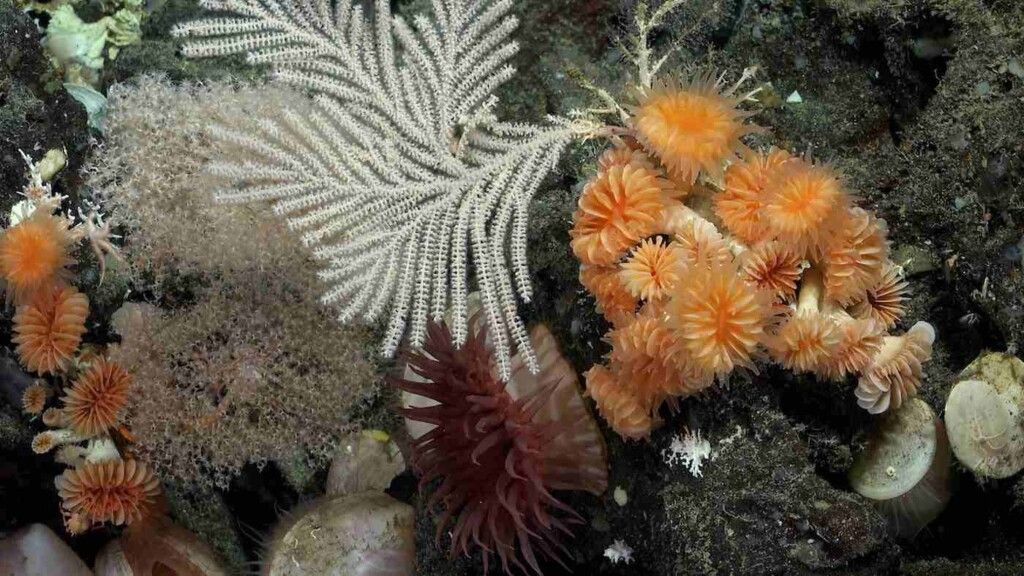Journey to the Depths: Ancient Coral Reefs Unveil Secrets of the Hidden Ocean World
Deep-sea exploration has always held an air of mystery and excitement. When the Schmidt Ocean Institute embarked on its latest expedition little did they know that they would stumble upon a breathtaking discovery that would captivate the world. Two pristine ancient coral reefs hidden from human eyes for thousands of years were uncovered revealing a thriving ecosystem teeming with life deep beneath the ocean's surface.
Normally we think of coral reefs as shallow-water wonders flourishing within 120 feet of the sea's surface. However these newfound coral reefs referred to as cold-water or stony coral exist at depths ranging from 1200 to 1375 feet. Their existence at such extreme depths is a testament to their resilience and adaptability.

The larger of the two reefs stretches an impressive distance of 800 meters equivalent to eight football fields while the smaller one measures a still remarkable 250 meters. Both reefs are home to an astonishing variety of stony coral species showcasing their ability to nurture and sustain marine biodiversity throughout the ages.
Among the mesmerizing inhabitants of these reefs are enchanting sea fans also known as Gorgonians as well as unique hexacorallia corals including deep-sea corals and sea anemones. These extraordinary organisms have evolved to thrive in the challenging conditions of the deep ocean where sunlight is scarce and the water pressure is immense.
Interestingly these pristine coral reefs discovered in the Galapagos Island Marine Reserve are not the first of their kind. Earlier this year scientists from the Woods Hole Oceanographic Institution found the first deep-sea coral reef during a research expedition on a dedicated vessel. The recent Schmidt expedition under the leadership of Dr. Katleen Robert involved 24 scientists from 13 organizations and universities each contributing their expertise to further unravel the mysteries of these unique ecosystems.
To study and document these incredible reefs the scientists utilized cutting-edge laser scanning technology. With an astonishing resolution of 2 millimeters these detailed maps provided invaluable insights into the topography and structure of the reefs and their surrounding environment. Such high-resolution mapping proved essential in understanding the coral reefs' existence and their interconnectedness with the underwater mountains known as seamounts just a stone's throw away.
However the discoveries did not end with the hidden coral reefs of the Galapagos Islands. The expedition also ventured into the depths of Isla del Coco National Marine Park a protected area managed by Costa Rica. Exploring the coral communities on seamounts in both the Galapagos and Costa Rica shed new light on the connections and interdependence of these mesmerizing ecosystems.

One dive during the expedition left the researchers in awe as they stumbled upon deep-sea corals laden with eggs. This astonishing discovery of reproductive activity at such great depths hints at the resilience and thriving nature of these hidden worlds. Moreover these findings contribute to our understanding of the Eastern Tropical Pacific Marine Corridor a network of interconnected marine reserves managed by the governments of Ecuador Costa Rica Panama and Colombia vital for the conservation of our oceans.
The significance of these pristine coral reefs in the Galapagos Marine Reserve cannot be overstated. Not only do they provide a wealth of scientific data for researchers they also serve as a crucial foundation for the protection and conservation of these invaluable ecosystems. By safeguarding the biodiversity and resilience of these reefs we can ensure their survival in the face of a rapidly changing environment.
Stuart Banks CEO of the Charles Darwin Foundation underlines the importance of preserving these hidden dimensions of ocean diversity. The Galapagos Marine Reserve is an integral part of a larger network of marine protected areas across the Eastern Pacific. The discovery of these deep and long-lived reefs is a significant stride towards effective management and conservation of these precious habitats.
In conclusion the recent exploration in the Galapagos Islands has unraveled the hidden depths of our oceans uncovering ancient coral reefs brimming with life. These extraordinary reefs adorned with stony corals and sea fans have silently nurtured marine life for countless millennia. The invaluable data and insights gained from this expedition will undoubtedly contribute to the better management and conservation of these unique ecosystems. Protecting these coral reefs is not just about their awe-inspiring beauty; it's about safeguarding the health and biodiversity of our oceans for generations to come.
So let us celebrate this extraordinary journey to the depths—a journey that not only opens our eyes to the wonders of the underwater world but also reminds us of the urgent need to protect and preserve these hidden treasures beneath the waves. Only by joining hands can we ensure the survival of these ancient coral reefs and the myriad of life they nurture inspiring awe and wonder in all those who witness their splendor.
As we delve deeper into the secrets of the ocean it becomes increasingly clear how interconnected our planet's ecosystems are. The discovery of these amazing coral reefs highlights the delicate balance needed to maintain the health of our oceans. It serves as a reminder that every action we take no matter how small can have an impact on these fragile ecosystems.

Efforts to protect and conserve coral reefs have become more crucial than ever. Climate change pollution and overfishing pose significant threats to these delicate ecosystems. By adopting sustainable practices and implementing effective conservation measures we can contribute to the preservation of these ancient coral reefs and the countless species that depend on them.
Education and awareness are also vital in preserving coral reefs. Public understanding of their importance and the need to protect them can lead to widespread support for conservation initiatives. Through education programs outreach campaigns and media engagement we can foster a sense of responsibility towards these magnificent underwater worlds.
Furthermore collaboration among governments organizations and communities is key in conserving coral reefs. International agreements and initiatives can help establish protected areas and regulate activities that may harm these delicate ecosystems. Local communities especially those whose livelihoods depend on the oceans can play an essential role in safeguarding coral reefs through sustainable fishing practices and responsible tourism.
In conclusion the discovery of these ancient coral reefs thriving in the depths of the Galapagos Islands unveils a hidden world of wonder and biodiversity. These remarkable ecosystems brimming with life and resilience remind us of the interconnectedness of our planet's ecosystems and the urgent need to protect and conserve them. By acting collectively we can ensure the survival of these ancient coral reefs for generations to come preserving their beauty and contributing to the health of our oceans. Let this revelation be a call to action inspiring us to safeguard these precious treasures beneath the waves.

